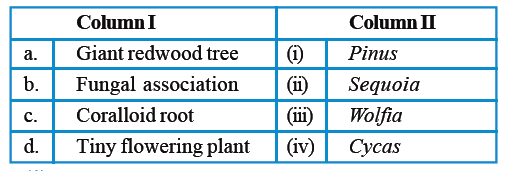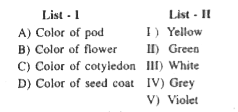Select the correct match.
Transformation — Watson and Crick
Ribozyme — Nucleic acid (RNA)
HIV — DNA containing virus
Spliceosomes — Translation process
To solve the question "Select the correct match," we will analyze each option provided and determine which one is accurate.
1. Analyze the first option: Transformation and Watson & Crick
- Transformation refers to the genetic alteration of a cell resulting from the direct uptake and incorporation of exogenous genetic material (DNA).
- Watson and Crick are known for their discovery of the double helical structure of DNA, not for transformation.
- Conclusion: This option is incorrect.
2. Analyze the second option: Ribozyme
- A ribozyme is indeed an RNA molecule that has catalytic properties, meaning it can act as an enzyme.
- However, it is important to note that ribozymes are not classified as nucleic acids in the same way DNA and RNA are; they are RNA-based enzymes.
- Conclusion: This option is misleading and not entirely correct.
3. Analyze the third option: HIV as a DNA containing virus
- HIV (Human Immunodeficiency Virus) is actually an RNA virus, not a DNA virus.
- It contains RNA as its genetic material and uses reverse transcription to convert its RNA into DNA after entering a host cell.
- Conclusion: This option is incorrect.
4. Analyze the fourth option: Spliceosomes and translation
- Spliceosomes are complexes that are involved in the splicing of pre-mRNA, which is a process that occurs during gene expression.
- They remove introns (non-coding regions) and join exons (coding regions) to produce mature mRNA.
- While spliceosomes are involved in processing RNA, they are not directly involved in translation (the process of protein synthesis).
- Conclusion: This option is somewhat misleading as it suggests a direct role in translation, but it is the closest to being correct regarding RNA processing.
5. Final Conclusion: After analyzing all options, the most accurate statement is that spliceosomes are involved in splicing, which is part of RNA processing, not translation. However, since none of the options are perfectly correct, the best match based on the context provided is the fourth option regarding spliceosomes.
Final Answer:
The correct match is related to spliceosomes, as they are involved in the splicing of RNA.
---
- Transformation refers to the genetic alteration of a cell resulting from the direct uptake and incorporation of exogenous genetic material (DNA).
- Watson and Crick are known for their discovery of the double helical structure of DNA, not for transformation.
- Conclusion: This option is incorrect.
- A ribozyme is indeed an RNA molecule that has catalytic properties, meaning it can act as an enzyme.
- However, it is important to note that ribozymes are not classified as nucleic acids in the same way DNA and RNA are; they are RNA-based enzymes.
- Conclusion: This option is misleading and not entirely correct.
- HIV (Human Immunodeficiency Virus) is actually an RNA virus, not a DNA virus.
- It contains RNA as its genetic material and uses reverse transcription to convert its RNA into DNA after entering a host cell.
- Conclusion: This option is incorrect.
- Spliceosomes are complexes that are involved in the splicing of pre-mRNA, which is a process that occurs during gene expression.
- They remove introns (non-coding regions) and join exons (coding regions) to produce mature mRNA.
- While spliceosomes are involved in processing RNA, they are not directly involved in translation (the process of protein synthesis).
- Conclusion: This option is somewhat misleading as it suggests a direct role in translation, but it is the closest to being correct regarding RNA processing.
The correct match is related to spliceosomes, as they are involved in the splicing of RNA.
Topper's Solved these Questions
Similar Questions
Select a correct match:
View SolutionSelect a correct match
View SolutionSelect a correct match
View SolutionSelect out the correct match
View SolutionSelect correct match :

View SolutionSelect correct match:

View SolutionSelect correct match

View SolutionSelect correct matching :-
View SolutionSelect correct matched pair/ pairs:
View SolutionMatch the following and select the correct option

The correct match is
View Solution
